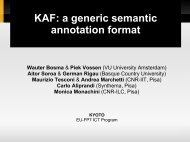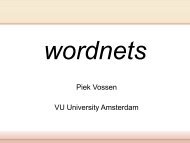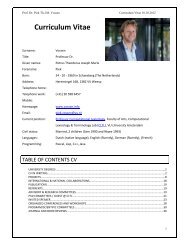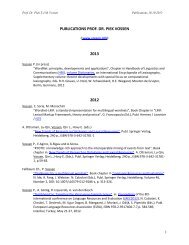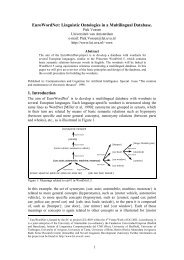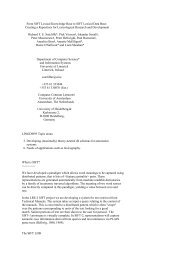Integrating lexical units, synsets and ontology in ... - Prof. Piek Vossen
Integrating lexical units, synsets and ontology in ... - Prof. Piek Vossen
Integrating lexical units, synsets and ontology in ... - Prof. Piek Vossen
Create successful ePaper yourself
Turn your PDF publications into a flip-book with our unique Google optimized e-Paper software.
4. Align<strong>in</strong>g Manually RBN with DWN<br />
The total number of form <strong>units</strong> (FUs) <strong>in</strong> CDB after the<br />
automatic alignment is 90.000. About 37.000 occur <strong>in</strong><br />
both RBN <strong>and</strong> DWN, 6.000 only occur <strong>in</strong> RBN <strong>and</strong><br />
47.000 only <strong>in</strong> DWN.<br />
FUs both <strong>in</strong> RBN <strong>and</strong> DWN 37.000<br />
FUs <strong>in</strong> RBN only 6.000<br />
FUs <strong>in</strong> DWN only 47.000<br />
Total number of entries (= FUs) <strong>in</strong> Cornetto 90.000<br />
Table 2: Form <strong>units</strong> <strong>in</strong> the Cornetto database<br />
Most of the shared form <strong>units</strong> have a s<strong>in</strong>gle mean<strong>in</strong>g <strong>in</strong><br />
DWN <strong>and</strong> RBN. Most of these are also aligned: 22.000<br />
FUs (60% ). About 2.200 FUs (6%) with a s<strong>in</strong>gle mean<strong>in</strong>g<br />
<strong>in</strong> RBN <strong>and</strong> DWN could not be aligned due to lack of<br />
match<strong>in</strong>g <strong>in</strong>formation. In the case of biseme FUs, 250<br />
have a direct match across DWN <strong>and</strong> RBN <strong>and</strong> 2.500<br />
have at least one non-match<strong>in</strong>g LU or synset.<br />
The monoseme <strong>and</strong> biseme cases are considered to be<br />
reliable. The next manual alignment step consists of<br />
edit<strong>in</strong>g low-scor<strong>in</strong>g <strong>and</strong> non exist<strong>in</strong>g l<strong>in</strong>ks between<br />
<strong>lexical</strong> <strong>units</strong> <strong>and</strong> <strong>synsets</strong>. We identified four groups of<br />
problematic cases <strong>and</strong> def<strong>in</strong>ed edit<strong>in</strong>g guidel<strong>in</strong>es for them<br />
which will be presented <strong>in</strong> the follow<strong>in</strong>g sections. The<br />
manual work <strong>in</strong>volves:<br />
- mapp<strong>in</strong>g of RBN <strong>and</strong> DWN:<br />
- mapp<strong>in</strong>g of DWN to English Wordnet 2.0<br />
- mapp<strong>in</strong>g of DWN to Wordnet Doma<strong>in</strong> labels<br />
- mapp<strong>in</strong>g of DWN to SUMO <strong>and</strong> MILO<br />
All manual changes are logged <strong>and</strong> marked. For all<br />
automatically derived words <strong>and</strong> senses, we will extract<br />
samples <strong>and</strong> derive a quality estimate for each of the 4<br />
mapp<strong>in</strong>gs.<br />
Mapp<strong>in</strong>g RBN to DWN <strong>in</strong>volves:<br />
- l<strong>in</strong>k<strong>in</strong>g RBN LUs to exist<strong>in</strong>g <strong>synsets</strong> or creat<strong>in</strong>g<br />
new <strong>synsets</strong> for unl<strong>in</strong>ked LUs.<br />
- add m<strong>in</strong>imal <strong>in</strong>formation to new LUs from DWN<br />
- remov<strong>in</strong>g spurious LUs<br />
- remov<strong>in</strong>g spurious <strong>synsets</strong><br />
- merge or split LUs<br />
- merge or split Synsets<br />
We will discuss this work <strong>in</strong> more detail <strong>in</strong> the next four<br />
subsections.<br />
4.1 Frequent polysemous verbs <strong>and</strong> nouns<br />
The low-scor<strong>in</strong>g l<strong>in</strong>ks with<strong>in</strong> the group of verb <strong>synsets</strong><br />
<strong>and</strong> <strong>lexical</strong> <strong>units</strong> <strong>and</strong> with<strong>in</strong> the group of noun <strong>synsets</strong> <strong>and</strong><br />
<strong>lexical</strong> <strong>units</strong> (follow<strong>in</strong>g section) are <strong>in</strong> great deal due to<br />
the difference regard<strong>in</strong>g the underly<strong>in</strong>g pr<strong>in</strong>ciples of<br />
mean<strong>in</strong>g discrim<strong>in</strong>ation which plays an important role <strong>in</strong><br />
the alignment of <strong>synsets</strong> <strong>and</strong> <strong>lexical</strong> <strong>units</strong>.<br />
As long as there is a one-to-one mapp<strong>in</strong>g from LUs <strong>and</strong><br />
<strong>synsets</strong>, the features of the two resources will probably<br />
match. D ifficulties arise however when the mapp<strong>in</strong>g is not<br />
one-to-one. Frequent verbs are often very polysemous.<br />
The RBN, as the source of the LUs, tries to deal with<br />
polysemy <strong>in</strong> a systematic <strong>and</strong> efficient way. The <strong>synsets</strong>,<br />
however, are much more detailed on different read<strong>in</strong>gs.<br />
As a result, <strong>in</strong> many cases there are more <strong>synsets</strong> than LUs.<br />
In comb<strong>in</strong>ation with the detailed <strong>in</strong>formation on<br />
complementation, event structure <strong>and</strong> <strong>lexical</strong> relation, this<br />
results <strong>in</strong> <strong>in</strong>terest<strong>in</strong>g edit<strong>in</strong>g problems.<br />
A typical example of an economically created LU <strong>in</strong><br />
comb<strong>in</strong>ation with a detailed synset is aflopen (to come to<br />
an end, to go off (an alarm bell), to flow down, to run<br />
down, to slope down, etc.). Input to the alignment are<br />
seven LUs <strong>and</strong> 13 <strong>synsets</strong>. Much of the asymmetry was<br />
caused by the fact that one of the LUs represents one basic<br />
<strong>and</strong> comprehensive mean<strong>in</strong>g: to walk to, to walk from , to<br />
walk alongside someth<strong>in</strong>g or someone. In DWN these are<br />
all different mean<strong>in</strong>gs, with different <strong>synsets</strong>. This is the<br />
result of describ<strong>in</strong>g <strong>lexical</strong> mean<strong>in</strong>g by <strong>synsets</strong>; these<br />
three read<strong>in</strong>gs of aflopen obviously have a lot <strong>in</strong> common,<br />
but they match with different synonyms. Align<strong>in</strong>g the<br />
LU’s <strong>and</strong> <strong>synsets</strong> leads to splitt<strong>in</strong>g the LU’s <strong>and</strong> may lead<br />
to subtle changes <strong>in</strong> the complementation patterns, event<br />
structure <strong>and</strong> certa<strong>in</strong>ly to adapt<strong>in</strong>g <strong>and</strong> extend<strong>in</strong>g the<br />
comb<strong>in</strong>atorical <strong>in</strong>formation. Sometimes the LUs are more<br />
detailed. In that case a synset must be split, which of<br />
course gives rise to changes <strong>in</strong> all related <strong>synsets</strong> <strong>and</strong> to<br />
new sets of <strong>lexical</strong> relations. About 1000 most-frequent<br />
verbs are manually edited. More details are discussed <strong>in</strong><br />
<strong>Vossen</strong> et al 2008.<br />
4.2 Nouns <strong>and</strong> semantic shifts<br />
The RBN uses a semantic shift label for groups of words<br />
that show the same semantic polysemy pattern,<br />
represented by a s<strong>in</strong>gle condensed mean<strong>in</strong>g. DWN<br />
explicitly lists these mean<strong>in</strong>gs. Because of the difference<br />
<strong>in</strong> approach, the DWN resource will have an extra synset<br />
for the mean<strong>in</strong>g that is implied with a shift <strong>in</strong> the LU.<br />
There are about 30 different def<strong>in</strong>ed types of shifts that<br />
can occur <strong>in</strong> verbs, adjectives <strong>and</strong> nouns, like Process ?<br />
Action <strong>in</strong> verbs <strong>and</strong> Dynamic ? Non-dynamic <strong>in</strong> nouns.<br />
We expected that the match<strong>in</strong>g of LUs from RBN to<br />
synonyms <strong>in</strong> DWN is more likely to be <strong>in</strong>correct for all<br />
words labeled with a shift <strong>in</strong> RBN. We therefore decided<br />
to manually verify all the mapp<strong>in</strong>gs for shifts. The vast<br />
majority of 4500 LUs with a semantic shift is found <strong>in</strong><br />
nouns, on which we have decided to concentrate the<br />
manual work.<br />
The edit<strong>in</strong>g of these shift cases can be illustrated by the





